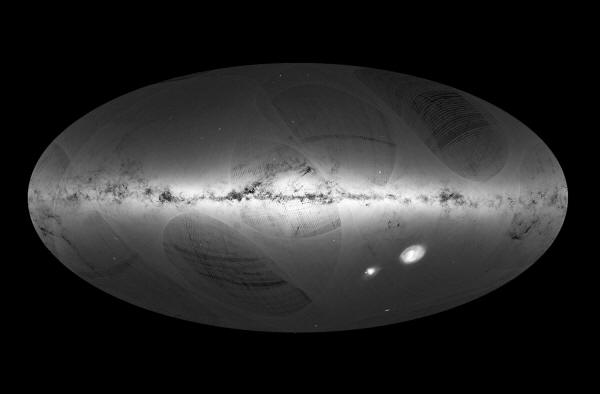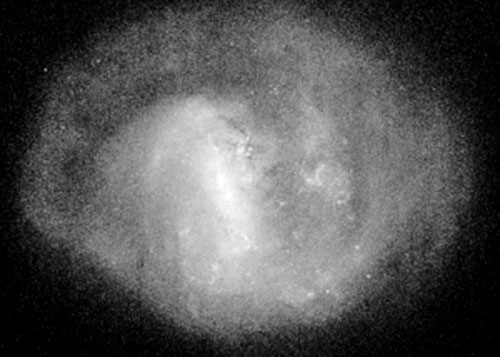|

by Davide Castelvecchi
14 September 2016
from
Nature Website
Voyage to
Praesepe
A virtual journey from the Solar System to the
Praesepe Cluster
(M44), some 577 light years
away, based on Gaia's 3D mapping of individual stars.
Gaia also measured
the velocities of some of the stars, represented here by arrows.
First results from Gaia
probe
also seem to solve old
controversy
over Pleiades cluster.
The European Space Agency (ESA) has released the largest, most
detailed map yet of the Milky Way.
It pinpoints the 3D positions of
1.1 billion stars, almost 400 million of which were previously
unknown to science.
ESA's
Gaia space observatory mapped out
the catalogue. The results are expected to transform what
astronomers
know about the Galaxy
- allowing
researchers to discover new extrasolar planets, examine the
distribution of dark matter and fine-tune models of how stars
evolve.
Hundreds of astronomers began to access
the
database as soon
as it was made publicly available on 14 September, says Gaia project
scientist Timo Prusti, who works at ESA's European Space Research
and Technology Centre in Noordwijk, the Netherlands.
"My advice to
the astronomical community is: please enjoy with us," he said at a
press conference in Madrid.
Within 24 hours, more than 11,000 users
had accessed the catalogue, ESA said, and independent teams have
begun to post papers based on Gaia data on the preprint repository
arXiv.
Gaia has already found more stars than
researchers expected, which suggests that the Milky Way is slightly
bigger than previously estimated, says Gisella Clementini, a Gaia
researcher at the Bologna Astronomical Observatory in Italy.
But few new results were announced at
the catalogue's unveiling, because Gaia's team was allowed to do
only limited analyses before the data release - unusual for space
observatories, whose mission scientists often have up to a year's
exclusive use of their data before sharing them with the world.
One notable result, however, is a
measurement of the distance of
the Pleiades,1
a cluster of stars in the constellation Taurus that has been the
subject of
a long-running controversy.
Whereas numerous measurements put
the Pleiades cluster at a distance of about 135 parsecs (440 light
years) from the Sun, Gaia's predecessor, ESA's
Hipparcos mission,
found it to be about 15 parsecs closer.
Gaia measured 134 parsecs, give or take
6 parsecs - suggesting that the Hipparcos findings were inaccurate.
Anthony Brown, an astronomer at the Leiden Observatory in the
Netherlands who chairs Gaia's data-processing collaboration,
stresses that the results are preliminary and that they could change
once Gaia collects more data.
(Ultimately, Gaia should be the first
mission able to measure the distances of individual stars in the
cluster, rather than an average.)
But there's scant possibility that Gaia's results will be corrected so much that they agree with the
Hipparcos results, thinks David Soderblom, an astronomer at the
Space Telescope Science Institute in Baltimore, Maryland.
"It's not
impossible but it sure isn't very likely at this point," he says.
"That, to me, is basically the answer."
Soderblom expects that the
trouble with the Hipparcos measurement may have been in corrections
made to account for the unusual brightness of stars in the cluster.

The Milky Way and its neighbouring
galaxies
are shown in this map based on Gaia satellite data:
brighter regions indicate denser concentrations of stars.
Gaia launched in late 2013 and
started its scientific mission in July 2014.
The spacecraft cost
€450 million (US$500 million), but the mission's total cost,
including the expense of operations and running data centres, is
close to €1 billion. The preliminary catalogue released today is
based on Gaia's first 14 months of data-taking.
Gaia does not take
still exposures as ordinary telescope cameras do:
instead, it
constantly spins on its axis, making a full revolution every six
hours and tracking the streaks that stars leave along its
1-gigapixel detector.

ESA/Gaia/DPAC
A reconstruction of the Large Magellanic
Cloud
based on Gaia data.
By comparing scans of the sky taken
six months apart, researchers are able to triangulate and
measure stars' distances using the parallax effect, a technique
that dates back to ancient Greece.
In the first release of Gaia's catalogue, more than two million stars have been
labeled
both with measurements of their distances from the Sun and their
motion, obtained by comparing Gaia data with those from
Hipparcos.
In future releases, the catalogue will grow to
include the distances and velocities of more than one billion
stars.
With more years of observation,
Gaia's measurements will become so accurate that the distances
of many of the Galaxy's stars will be pinpointed to within 1%.
"What Gaia is going to do is going
to be phenomenal," says Wendy Freedman, an astronomer at the
University of Chicago in Illinois. "It will be the fundamental
go-to place for astronomers for decades to come."
References
1.
Brown, A. G. A. et al.
Astron. Astrophys -
Gaia Data Release 1 - Summary of the
Astrometric, Photometric, and Survey Properties - (2016).
One notable result, however, is a
measurement of the distance of the Pleiades,
a cluster of stars in the constellation Taurus that has been the
subject of a long-running subject. See "Controversy
Reignites over Distance of Pleiades Star Cluster".
|



